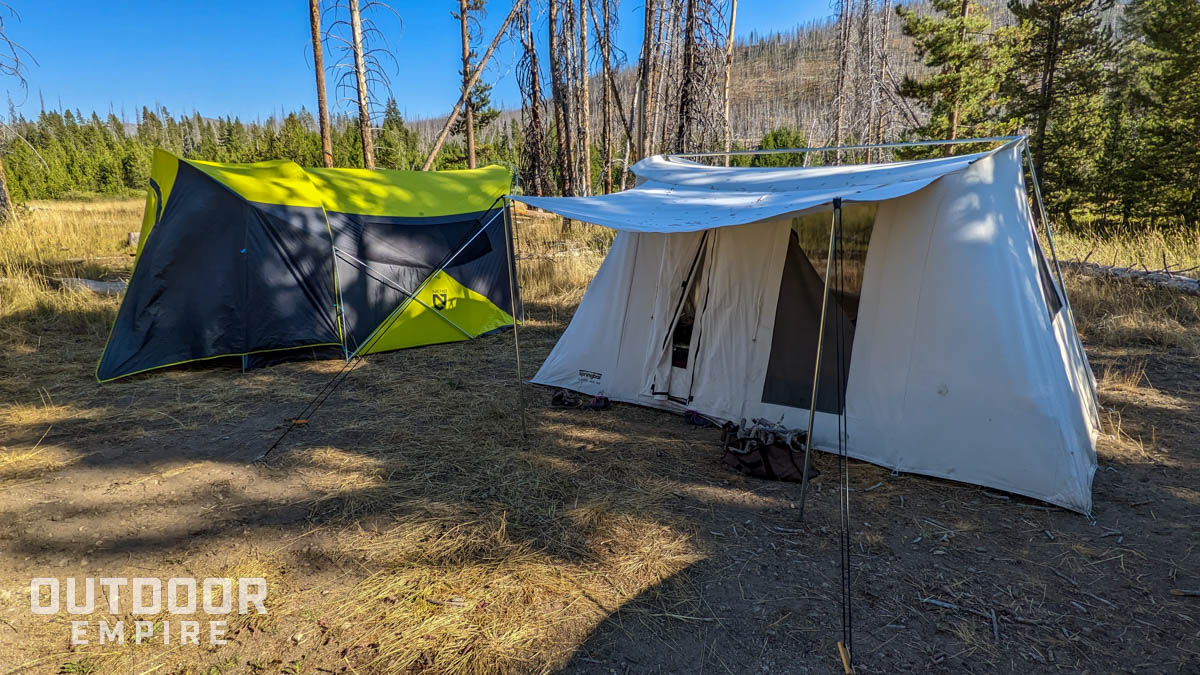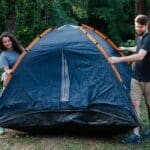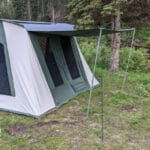If you’re starting your journey into camping and looking to purchase your first tent, you may be wondering how much you should spend. Or, maybe you’ve realized you love camping and it’s time to upgrade to a tent that will best suit your needs for the long term. There are a lot of options on the market for camping tents.
Tents come in a wide range of prices. For this article, I compared prices and options between a few big retailers. Looking at REI, Backcountry, Cabela’s, Walmart, and other retailers, I’ve compiled all the data you need to make an informed decision on your tent budget.
At the beginning of 2024, the average price range of a camping tent is about $50 to $300. Variables such as size, intended use, seasonality, and extra features will affect the cost. You can purchase a good tent at either end of this price range, depending on what you’re looking for.
Read on for a detailed breakdown of tent prices as well as our best tips on how you can save some money!
DISCLOSURE: As an Amazon Associate I earn from qualifying purchases. Some links in this article are affiliate links. If you click on a link we may earn a commission if you make a purchase, at no additional cost to you.
How Much Does a Tent Cost?
The cost of a camping tent will depend on what type of tent you’re looking for and what variables are important to you. A small car camping tent without extra features may cost only $30.
The price will go up as you increase in size, additional features, and durability. The average cost of a camping tent will be $50 to $300 but can be as high as $700 for a high-end, ultralight backpacking tent.
In a nutshell, here is a list of variables that will factor into the price of your tent. I’ll go more in-depth into these points below.
More expensive:
- Larger, multiple-person tents
- Rain fly included
- Footprint included
- Built-in lighting
- Lightweight backpacking tents
- Durable canvas tents
- Three-season or four-season tents
- Recognizable brand name
Less expensive:
- One-person tents (they are quite small!)
- Lower-quality materials such as polyester or plastic material
- Smaller brands without name recognition
- One-season, fair-weather-only tents
- No rain fly or waterproofing
- Bulkier, heavier backpacking tents
- Older designs or used tents
- Budget retailers such as Walmart
Comparing Tent Prices
Important Note: Product prices change all the time by both manufacturers and retailers. We don’t sell tents and the data and prices listed in this article don’t represent any kind of price guarantee. They’re just based on our own research and observations.
Below is a comparison of a few types of tents and their prices.
| Type of tent | Good | Better | Best |
| 2-person backpacking tent (including ultralight) | $50-$150 | $150-$400 | $400-$700+ |
| 2-person car camping tent | $40-$80 | $80-$140 | $140-$250+ |
| 2-person canvas tent | $100-$200 | $200-300 | $300-$500+ |
| 8-person canvas tent | $400-$500 | $500-$600 | $600-$1,000+ |
| 8-person car camping tent | $180-$200 | $200-$250 | $250-$400+ |
Remember that a higher price doesn’t necessarily mean a tent is higher quality or more durable. Make sure you do a thorough read-through of a tent’s specifications, materials, and extra features before you make a purchase.
I recommend checking out a tent in-person at a physical retailer if possible. That’s also a great way to chat with experts who have likely tried many of the options you’re considering and can help guide you.
Tent Price Comparison Chart by Retailer
We researched tent prices at several different retailers and here is what we found. There’s a whole section down below on Walmart as well.
| Retailer | Low | Median | High |
| REI (car or family camping tent) | $125 | $350 | $2,000 |
| REI (backpacking tent) | $150 | $450 | $920 |
| Cabela’s or Bass Pro Shops | $30 | $300 | $2,000 |
| Sportsman’s Warehouse | $50 | $250 | $1,600 |
| Academy Sports | $20 | $220 | $1,000 |
| Decathlon | $20 | $190 | $1,100 |
| Amazon | $20 | Unknown | $20,000 |
| Temu | $5 | Unknown | $770 |
What Makes a Tent More Expensive?
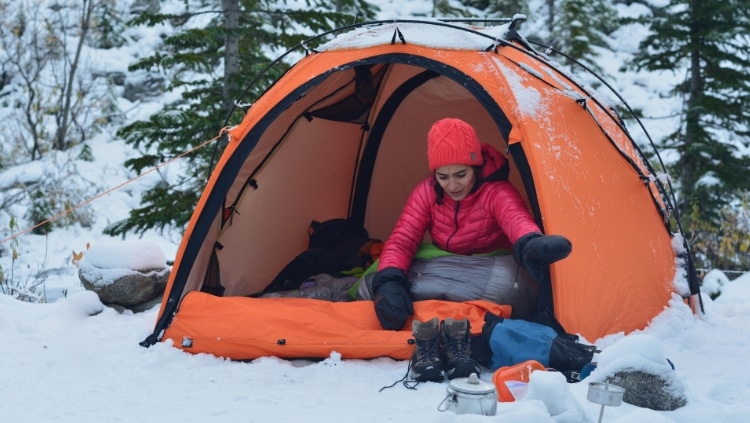
Tent Size
As a rule of thumb, the larger the size, the larger the price. This is true no matter what type of tent you’re looking at.
You can find tents ranging in size from one-person up to ten-person or more. These larger tents may even have more than one room. Even without any additional bells and whistles, size alone can dictate a wide variety of prices.
Tent Seasonality
A three-season tent is the most common type of tent to find as far as seasonality goes. A tent without extra weatherproofing for colder fall temperatures or spring rain will be less expensive. A four-season tent for use in the winter will be at the top of the price range in this department.
You can even go beyond this and purchase a tent for extreme weather and temperatures. These are called mountaineering or “five-season” tents.
Most tents will be marketed as either single-wall or double-wall tents. Three-season, and especially four-season, tents are nearly always double-wall tents.
Single-wall: A single-wall tent may not have any screen windows and just be a solid piece of nylon or polyester. This includes a lot of cheap tents but also high-end ultralight backpacking tents, including what you hear referred to as tarps or simply shelters.
Single-wall tents tend to build up condensation on the inside, which is a real bummer when the tent wall touches your sleeping bag and gets it all wet.
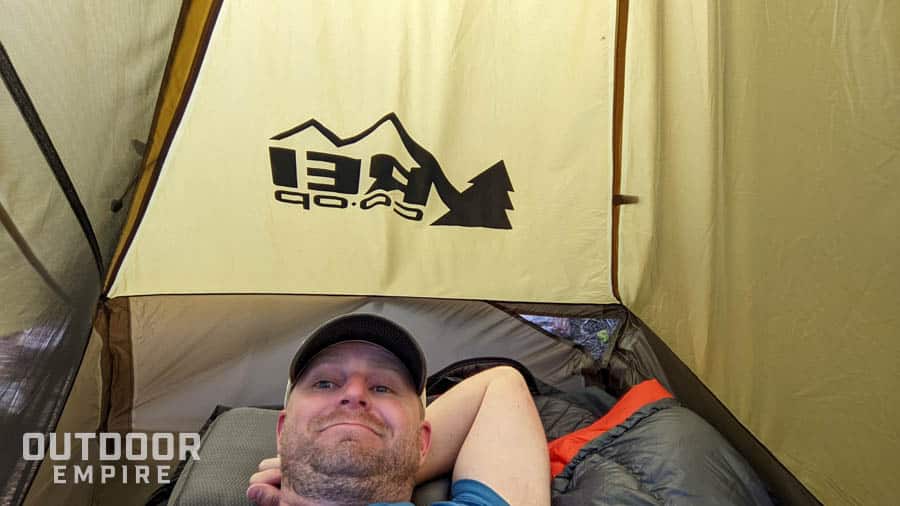
Double-wall: Double-wall tents are generally considered more weatherproof and comfortable because moisture will condense or build up on the outer wall instead of the inner wall that comes in contact with you and your gear.
The inner wall is often all screen mesh, and the outer wall may be a separate nylon rainfly. In many cases, both walls are sewn together in a single construction to save on weight.
While they are generally more expensive than single-wall tents, double-wall tents often hold up better in wind, rain, and snow. They are more versatile for use over three to four seasons in various environments.
Rain Fly
Some budget tents may not come with a rain fly included. A rain fly is an additional waterproof tent material pitched over your tent to keep the rain out. As you increase in price and quality, a tent should come with a rain fly as part of the package. If you only camp in sunny, fair weather, this may not be an issue for you.
However, if you plan camping in areas where the weather can change quickly and without notice, such as high alpine environments, you will want to carry a rain fly.
They also provide extra shade and privacy to a tent. I find this useful, especially with lighter-weight tents that may mostly be mesh.
Tent Material
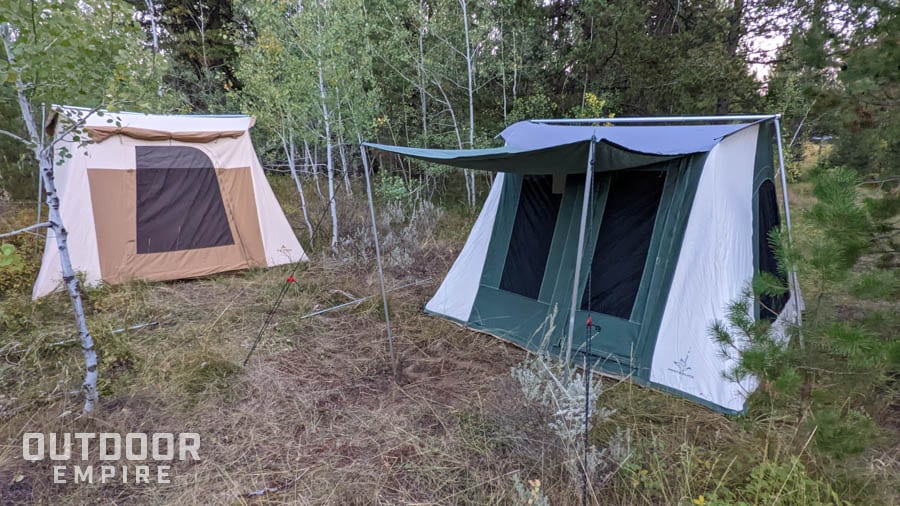
The type of material used in your tent will also affect the price. At the lower end of the price range will be tents made of polyester or other cheaper plastic materials.
Canvas tents will be more expensive, but they will be more durable and well-suited to long-term camping and living in the woods. Canvas tents are available in various sizes and designs, such as bell tents, tent cabins, and more traditional camping tent designs.
A backpacking tent made of lightweight materials such as nylon will also be a higher price. Backpacking tents are at the highest side of the price range, though they can be comparable with the cost of an excellent car-camping tent. Once you start getting into ultralight designs, the price jumps to over $400.
Recommended: Best Canvas Tents
Brand Names
Major brands may also sit at a higher price point than smaller brands because of name recognition. Brands that people trust for high-quality tents will vary depending on the type of camping you’re doing, but a few are Kelty, Big Agnes, Nemo, Marmot, REI, and Mountain Hardwear.
These brands make various models but are mostly known for high-quality car camping and backpacking tents.
There are also recognizable brands for car camping at lower price points, such as Coleman.
These are just a few brands on the market – there are many more. I have some favorite brands but honestly, the brand is one of the last things I consider when purchasing a tent. Many of these brands are making similar designs to each other.
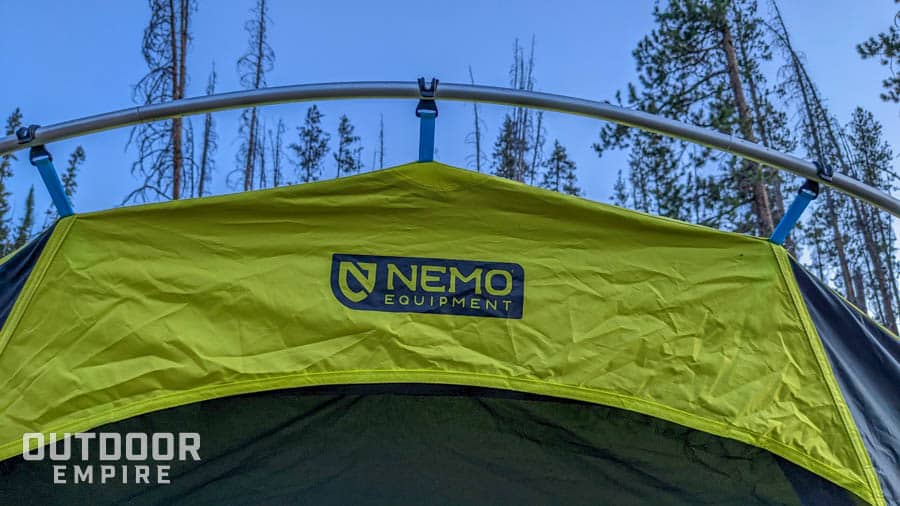
How Much Are Camping Tents at Walmart?
Walmart is a common retailer of tents on a lower budget. They carry camping tents in the price range of about $30 to $150, on average. You will also see a couple of options in the ballpark of $200 or more for an 8-person size.
I’d recommend staying within the $50 to $100 price range for most people’s needs. This will get you a relatively durable car camping tent that will be large enough for two people.
Types of Tents at Walmart
Walmart is a good option for purchasing the following types of tents:
- Entry-level, budget car-camping tents
- Mid-range car-camping tents
- Large, budget-friendly family tents (8+ person size)
You can also purchase different types of tents at Walmart, such as canopies or pop-up tents. Both of these are easy shelters to add to a car camping experience. They will be slightly more expensive than a regular tent but are great for keeping you out of the sun while hanging out at your campsite.

Should You Buy a Tent at Walmart?
The tents at Walmart are generally not considered high-end, though they carry some well-known entry-level brands such as Coleman and Ozark Trail that are still a good option. These are great if you’re just getting into car camping.
They also carry a range of larger, family-sized tents by these brands. Walmart is a good place to purchase tents if you’re on a strict budget.
Additionally, if you’re just starting to build your camping supplies and have a lot of things to get, purchasing some of the cheaper items at Walmart can be a great way to build your arsenal without breaking the bank.
Backpacking Tents at Walmart
Walmart doesn’t focus its offerings too much on tents well-suited for backpacking. They do carry a few entry-level backpacking tents, but I don’t really recommend purchasing a backpacking tent at Walmart.
If you’re seeking a tent to hike with, an outdoor-specific retailer will have a wider selection of higher-quality options. They won’t have these low Walmart prices, but a good backpacking tent generally is a higher investment.
Comparing Tent Prices at Walmart
| Type of tent | Good | Better | Best |
| 1-person car camping tent | $30-$70 | $70-$120 | $120-$200 |
| 2-person car camping tent | $40-$80 | $80-$140 | $140-$250 |
| 8-person car camping tent | $100-$120 | $120-$170 | $170-$250 |
| Canopy tents | $50-$90 | $90-$140 | $140-$300 |
How Much Should You Spend on a Backpacking Tent?
Backpacking tents are more expensive because you’re paying for finer quality materials that weigh much less than car camping materials. There’s no way you could carry an 80-pound car camping tent up the side of a mountain. You’ve got to pay a bit more for the lighter materials so you can actually carry your tent on your back for a few miles.
An average price point for a backpacking tent is $300 to $400. However, ultralight tents can range from $500 to $700. The lighter the weight of a backpacking tent, the more expensive it will be.
You’ll find heavier tents generally made of lower-quality, bulkier materials at the lower end of this price range. At the higher end, you’ll find ultralight tents weighing only a few pounds and packed down to be super compact.
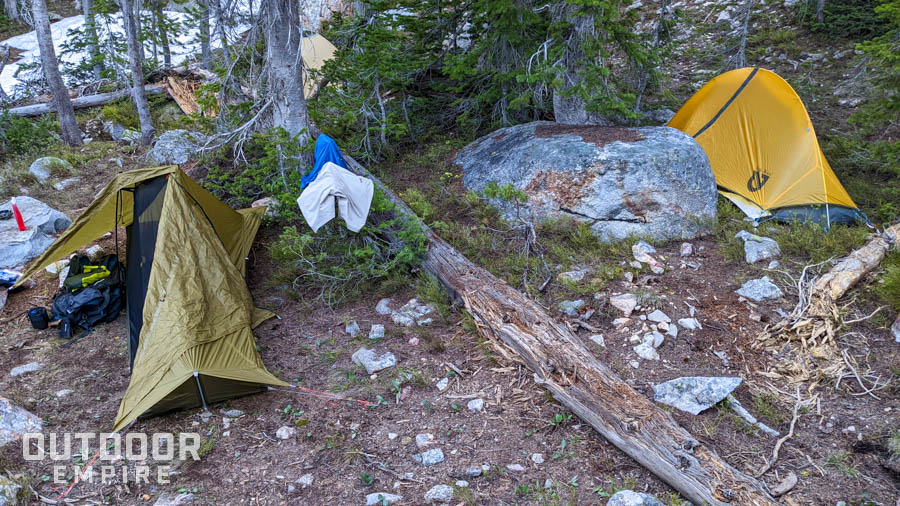
Ultralight Backpacking Tents
If you plan on doing extended backpacking trips or thru-hikes, you may want to invest more money into an ultralight tent. These types of backpacking tents are minimalist.
They use high-quality, lightweight materials like nylon and have simple designs without many bells and whistles. As a result, they cut down considerably on weight and space inside your pack, making for a more comfortable trip.
Trekking Pole Ultralight Tents
Some hikers have started using trekking pole tents. These ultralight models are the most minimalist of any backpacking tent available.
Usually, in a one-person size and without much room to speak of, they are extremely simple and lightweight. The attraction of a trekking pole tent is that you will save weight by not carrying additional tent poles. These tents are set up using the trekking poles you are already carrying on your hike.
Do You Need An Ultralight Tent?
If you haven’t reached a point with your backpacking where weight is of major importance to you, a regular backpacking tent will probably work fine for most of your trips. This is especially true if you’re only going out a few weekends per year.
Some avid backpackers still prefer a heavier tent for its added comfort and functionality. A non-ultralight backpacking tent may have additional features that would’ve been sacrificed for weight in an ultralight tent.
Backpacking Tent Price Comparison Chart
| Type of tent | Good | Better | Best |
| 1-person non-ultralight backpacking tent | $50-$70 | $70-$120 | $120-$200+ |
| 2-person non-ultralight backpacking tent | $50-$100 | $100-$300 | $300-$500+ |
| Trekking pole tents | $100-$150 | $150-$300 | $300-$400+ |
| 1-person ultralight tent | $150-$200 | $200-$400 | $400-$600+ |
| 2-person ultralight tent | $200-$300 | $300-$450 | $450-700+ |
How Can You Save Money on a Tent?
There are a few tricks to saving money on a camping tent:
1. Off-season Sales
Big outdoor retailers such as REI have annual sales with steep discounts on everything from clothing to tents. Generally, these happen during the winter months. Indie outdoor stores may have sales during the winter as well. Outdoor gear can be cheaper when it’s out of season, and it’s a good way to get some deals. In the US, there are often big outdoor gear sales in-season around Memorial Day and Independence Day.
2. Buy Used Gear
Buying used is another option. Your local gear shop may have a used section with great deals. I’m personally a big supporter of buying your camping gear used whenever you can. Often these tents will still be in great shape and have a ton of life left in them. This is a sustainable way to get out into nature on a budget.
3. Rent a Tent
You can try renting a tent if you’re not sure you want to commit to buying one quite yet. This is a good way to test out a particular tent you’re also considering purchasing.
Check with the gear shops in your area to see which tents they have available for you to take on a test run. This way, you avoid investing your money in a tent that doesn’t work for you. You’ll save money in the long run by knowing that you love the tent you’re purchasing.

